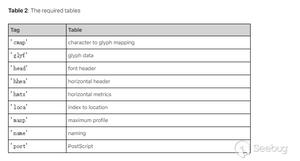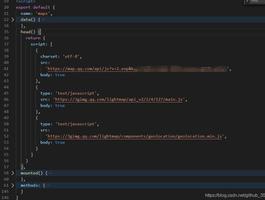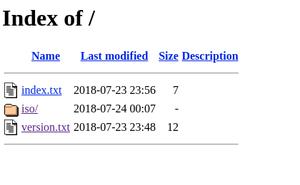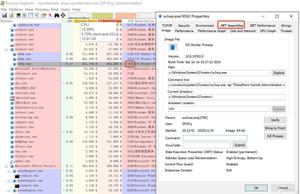Java Thread系列(十)Future 模式

Future 模式适合在处理很耗时的业务逻辑时进行使用,可以有效的减少系统的响应时间,提高系统的吞吐量。
一、Future 模式核心思想
如下的请求调用过程时序图。当 call 请求发出时,需要很长的时间才能返回。左边的图需要一直等待,等返回数据后才能继续其他操作;而右边的 Future 模式的图中客户端则无需等到可以做其他的事情。服务器段接收到请求后立即返回结果给客户端,这个结果并不是真实的结果(是虚拟的结果),也就 是先获得一个假数据,然后执行其他操作。
二、Future 实现
(1) FutureClient
Client主要完成的功能包括:1. 返回一个 FutureData;2.开启一个线程用于构造 RealData。
public class FutureClient { public FutureData request(final String queryStr) {
final FutureData future = new FutureData();
new Thread(new Runnable() {
@Override
public void run() {
future.request(queryStr);
}
}).start();
return future;
}
}
(2) Data
无论是 FutureData 还是 RealData 都实现该接口。
public interface Data { String getRequest();
}
(3) FutureData
FutureData 是 Future 模式的关键,它实际上是真实数据 RealData 的代理,封装了获取 RealData 的等待过程。
public class FutureData implements Data { private boolean isReady = false;
private RealData realData;
public FutureData() {
}
public synchronized void setRealData(RealData realData) {
if (isReady) {
return;
}
this.isReady = true;
this.realData = realData;
this.notify();
}
public void request(String queryStr) {
RealData realData = new RealData(queryStr);
this.setRealData(realData);
}
public synchronized String getRequest() {
if (!isReady) {
try {
wait();
} catch (InterruptedException e) {
;
}
}
return this.realData.getRequest();
}
}
(4) RealData
RealData 是最终需要使用的数据,它的构造函数很慢。
public class RealData implements Data { private String data;
public RealData(String queryStr) {
this.data = deal(queryStr);
}
public String deal(String queryStr) {
try {
Thread.sleep(1000 * 5);
} catch (InterruptedException e) {
;
}
return "这是处理后的结果...";
}
public String getRequest() {
return this.data;
}
}
(5) 测试
SimpleDateFormat format = new SimpleDateFormat("yyyy-MM-dd hh:mm:ss");FutureClient client = new FutureClient();
FutureData future = client.request("请求参数");
System.out.println(format.format(new Date()) + "发出请求...");
Thread.sleep(1000 * 2);
System.out.println(future.getRequest());
System.out.println(format.format(new Date()) + "收到结果...");
三、Future 模式的 JDK 内置实现
java.util.concurrent 已经内置了 Future 模式的实现。其中最为重要的是 FutureTask 类,它实现了 Runnable 接口,作为单独的线程运行。在其 run() 方法中,通过 Sync 内部类调用 Callable 接口,并维护 Callable 接口的返回对象。当使用 FutureTask.get() 方法时,将返回 Callable 接口的返回对象。
下面对 Callable、Future 和 FutureTask 进行浅析
Callable接口
我们先回顾一下java.lang.Runnable接口,就声明了run(),其返回值为void,当然就无法获取结果了。
public interface Runnable { public abstract void run();
}
而Callable的接口定义如下:
public interface Callable<V> { V call() throws Exception;
}
无论是 Runnable 接口的实现类还是 Callable 接口的实现类,都可以被 ThreadPoolExecutor 或 ScheduledThreadPoolExecutor 执行,ThreadPoolExecutor 或 ScheduledThreadPoolExecutor 都实现了 ExcutorService 接口,而因此 Callable 需要和 Executor 框架中的 ExcutorService 结合使用,我们先看看 ExecutorService 提供的方法:
// 返回封装了异步计算结果的Future<T> Future<T> submit(Callable<T> task);
// 指定调用Future的get方法时返回的result对象
<T> Future<T> submit(Runnable task, T result);
// 返回封装了异步计算结果的Future
Future<\?> submit(Runnable task);
因此我们只要创建好我们的线程对象(实现Callable接口或者Runnable接口),然后通过上面3个方法提交给线程池去执行即可。还有点要注意的是,除了我们自己实现Callable对象外,我们还可以使用工厂类Executors来把一个Runnable对象包装成Callable对象。Executors工厂类提供的方法如下:
public static Callable<Object> callable(Runnable task) public static <T> Callable<T> callable(Runnable task, T result)
Future接口
Future
public interface Future<V> { boolean cancel(boolean mayInterruptIfRunning);
boolean isCancelled();
boolean isDone();
V get() throws InterruptedException, ExecutionException;
V get(long timeout, TimeUnit unit) throws InterruptedException, ExecutionException, TimeoutException;
}
方法解析:
V get() :获取异步执行的结果,如果没有结果可用,此方法会阻塞直到异步计算完成。
V get(Long timeout , TimeUnit unit) :获取异步执行结果,如果没有结果可用,此方法会阻塞,但是会有时间限制,如果阻塞时间超过设定的timeout时间,该方法将抛出异常。
boolean isDone() :如果任务执行结束,无论是正常结束或是中途取消还是发生异常,都返回true。
boolean isCanceller() :如果任务完成前被取消,则返回true。
boolean cancel(boolean mayInterruptRunning) :mayInterruptRunning参数表示是否中断执行中的线程
如果任务还没开始,执行cancel(...)方法将返回false;
如果任务已经启动,执行cancel(true)方法将以中断执行此任务线程的方式来试图停止任务,如果停止成功,返回true;
当任务已经启动,执行cancel(false)方法将不会对正在执行的任务线程产生影响(让线程正常执行到完成),此时返回false;
当任务已经完成,执行cancel(...)方法将返回false。
通过方法分析我们也知道实际上Future提供了3种功能:(1)能够中断执行中的任务(2)判断任务是否执行完成(3)获取任务执行完成后额结果。
但是我们必须明白Future只是一个接口,我们无法直接创建对象,因此就需要其实现类FutureTask登场啦。
FutureTask 深度解析
我们先来看看FutureTask的实现
public class FutureTask<V> implements RunnableFuture<V> { }FutureTask类实现了RunnableFuture接口,我们看一下RunnableFuture接口的实现:
public interface RunnableFuture<V> extends Runnable, Future<V> { void run();
}
FutureTask 有两个很重要的属性,分别是 staterunner ,futureTask之所以可以支持cancel操作,就是因为这两个属性
其中 state为 枚举值:
NEW新建 0COMPLETING执行中 1NORMAL正常 2EXCEPTIONAL异常 3CANCELLED取消 4INTERRUPTING中断中 5INTERRUNPED被中断 6
state的状态变化可以有四种方式:
NEW->COMPLETING->NORMAL正常完成的流程NEW->COMPLETING->EXCEPTIONAL出现异常的流程NEW->CANCELED被取消NEW->INTERRUNPING->INTERRRUNPTED被中断
我们研究下Task的状态变化也就是一个任务的生命周期:
java源代码:
首先看一下 FutureTask 构造方法:
public FutureTask(Callable<V> callable) { if (callable == null)
throw new NullPointerException();
this.callable = callable;
this.state = NEW; // ensure visibility of callable
}
public FutureTask(Runnable runnable, V result) {
this.callable = Executors.callable(runnable, result);
this.state = NEW; // ensure visibility of callable
}
Task生命周期的变化,主要取决于 run()方法先被调用还是cancel () 方法会被调用,这两个方法的执行顺序决定了Task的生命周期的四种走向。我们先分析run方法先被调用的情况
public void run() { if (state != NEW ||
!UNSAFE.compareAndSwapObject(this, runnerOffset,
null, Thread.currentThread()))
return;
try {
Callable<V> c = callable;
// 如果要执行的任务不为空 并且状态 new 就执行
if (c != null && state == NEW) {
V result;
boolean ran;
try {
// 执行任务
result = c.call();
ran = true;
} catch (Throwable ex) {
// 有异常
result = null;
ran = false;
setException(ex);
}
if (ran)
set(result);
}
} finally {
// runner must be non-null until state is settled to
// prevent concurrent calls to run()
// 不管是否执行成功了,都把runner设置成null
runner = null;
// state must be re-read after nulling runner to prevent
// leaked interrupts
int s = state;
if (s >= INTERRUPTING)
handlePossibleCancellationInterrupt(s);
}
}
Task执行后如果成功会调用 set() 方法,如果有异常会调用 setException() 方法。
我们先看下set方法 :
protected void set(V v) { // (1) // 如过state是 NEW 把state设置成 COMPLETING
if (UNSAFE.compareAndSwapInt(this, stateOffset, NEW, COMPLETING)) {
outcome = v;
// 将任务设置成NORMAL
UNSAFE.putOrderedInt(this, stateOffset, NORMAL); // final state
finishCompletion();
}
}
如果现在的状态是 NEW 就把状态设置成 COMPLETING 然后设置成 NORMAL。这个执行流程导致的状态变化就是
NEW->COMPLETING->NORMAL
执行步骤是:首先执行 run() 并且Task正常完成而且在这其间没有调用 cancel()
上边是任务正常执行完成的状态变化,我们在看下有异常的情况。有异常的话会调用setException()方法:
protected void setException(Throwable t) { // (1) // 如过state是new 把state设置成 COMPLETING
if (UNSAFE.compareAndSwapInt(this, stateOffset, NEW, COMPLETING)) {
outcome = t;
// 将任务设置成 EXCEPTIONAL
UNSAFE.putOrderedInt(this, stateOffset, EXCEPTIONAL); // final state
finishCompletion();
}
}
如果现在的状态是 NEW 就把状态设置成 COMPLETING,然后设置成 EXCEPTIONAL。这个执行流程导致的状态变化就是
NEW->COMPLETING->EXCEPTIONAL
执行步骤是:首先执行 run() 并且Task抛出异常而且在这其间没有调用cancel()。
上文所分析的场景只是 run() 方法被调用了,而在run()方法执行的过程中没有调用cancel()
现在我们分析下cancel()方法先被调用的情况
public boolean cancel(boolean mayInterruptIfRunning) { // (1) /**
* 如果state不是 NEW 那么就退出方法,这时的任务任务坑是已经完成了,或是被取消了,或是被中断了
* 如果是state 是 NEW 就设置 state 为中断状态或是取消状态
*/
if (!(state == NEW &&
UNSAFE.compareAndSwapInt(this, stateOffset, NEW,
mayInterruptIfRunning ? INTERRUPTING : CANCELLED))) // (1)
return false;
try { // in case call to interrupt throws exception
// 如果是可中断,那么就调用系统中断方法,然后把状态设置成 INTERRUPTED
// 若 callable 内部有处理线程中断的机制,任务可能会中断
if (mayInterruptIfRunning) { // (2)
try {
Thread t = runner;
if (t != null)
t.interrupt();
} finally { // final state
UNSAFE.putOrderedInt(this, stateOffset, INTERRUPTED);
}
}
} finally {
finishCompletion();
}
return true;
}
如果是
cancel(false),那么Task的状态变化就是 NEW -> CANCELLED,不会对任务产生影响。如果是
cancel(true),那么Task的状态化就是 NEW -> INTERRUPTING -> INTERRUPTED,若 callable 内部有处理线程中断的机制,可能会任务产生影响。
Future之HelloWorld
SimpleDateFormat format = new SimpleDateFormat("yyyy-MM-dd hh:mm:ss");//ExecutorService pool = Executors.newFixedThreadPool(1);
FutureTask<Integer> future = new FutureTask<Integer>(new Callable<Integer>() {
@Override
public Integer call() throws Exception {
Thread.sleep(5 * 1000);
return new Random().nextInt(100);
}
});
System.out.println(format.format(new Date()) + "发出请求...");
new Thread(future).start();
//pool.submit(future);
try {
Integer ret = future.get();
System.out.println(format.format(new Date()) + "收到结果,ret = " + ret);
} catch (InterruptedException e) {
e.printStackTrace();
} catch (ExecutionException e) {
e.printStackTrace();
}
Future之ExecutorService
使用Callable和Future,通过ExecutorService的submit方法执行Callable,并返回Future,代码如下:
SimpleDateFormat format = new SimpleDateFormat("yyyy-MM-dd hh:mm:ss");ExecutorService pool = Executors.newSingleThreadExecutor();
System.out.println(format.format(new Date()) + "发出请求...");
Future<Integer> future = pool.submit(new Callable<Integer>() {
@Override
public Integer call() throws Exception {
Thread.sleep(5 * 1000);
return new Random().nextInt(100);
}
});
try {
Integer ret = future.get();
System.out.println(format.format(new Date()) + "收到结果,ret = " + ret);
} catch (InterruptedException e) {
e.printStackTrace();
} catch (ExecutionException e) {
e.printStackTrace();
}
代码是不是简化了很多,ExecutorService 继承自 Executor,它的目的是为我们管理Thread对象,从而简化并发编程,Executor使我们无需显示的去管理线程的生命周期,是JDK 5之后启动任务的首选方式。
Future之多任务
执行多个带返回值的任务,并取得多个返回值,代码如下:
SimpleDateFormat format = new SimpleDateFormat("yyyy-MM-dd hh:mm:ss");ExecutorService threadPool = Executors.newCachedThreadPool();
CompletionService<Integer> cs = new ExecutorCompletionService<Integer>(threadPool);
System.out.println(format.format(new Date()) + "发出请求...");
for(int i = 1; i < 5; i++) {
final int taskID = i;
cs.submit(new Callable<Integer>() {
public Integer call() throws Exception {
Thread.sleep(5 * 1000);
return taskID;
}
});
}
// 可能做一些事情
for(int i = 1; i < 5; i++) {
try {
System.out.println(format.format(new Date()) + ":" + cs.take().get());
} catch (InterruptedException e) {
e.printStackTrace();
} catch (ExecutionException e) {
e.printStackTrace();
}
}
每天用心记录一点点。内容也许不重要,但习惯很重要!
以上是 Java Thread系列(十)Future 模式 的全部内容, 来源链接: utcz.com/z/390129.html









